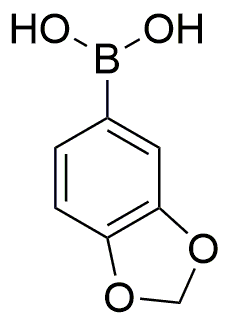3,4-(Methylenedioxy)phenylboronic acid is widely utilized in research focused on:
- Organic Synthesis: This compound serves as a key intermediate in the synthesis of various pharmaceuticals and agrochemicals, allowing for the development of new drugs and crop protection agents.
- Bioconjugation: It is used in bioconjugation techniques to attach biomolecules to surfaces or other molecules, enhancing drug delivery systems and diagnostic tools.
- Fluorescent Probes: The compound is employed in the creation of fluorescent probes for biological imaging, aiding researchers in visualizing cellular processes in real-time.
- Catalysis: It acts as a catalyst in cross-coupling reactions, which are essential in forming carbon-carbon bonds, thus streamlining the synthesis of complex organic molecules.
- Sensor Development: The unique properties of this boronic acid make it suitable for developing sensors that detect sugars and other biomolecules, which is valuable in medical diagnostics and food safety.
General Information
Properties
Safety and Regulations
Applications
3,4-(Methylenedioxy)phenylboronic acid is widely utilized in research focused on:
- Organic Synthesis: This compound serves as a key intermediate in the synthesis of various pharmaceuticals and agrochemicals, allowing for the development of new drugs and crop protection agents.
- Bioconjugation: It is used in bioconjugation techniques to attach biomolecules to surfaces or other molecules, enhancing drug delivery systems and diagnostic tools.
- Fluorescent Probes: The compound is employed in the creation of fluorescent probes for biological imaging, aiding researchers in visualizing cellular processes in real-time.
- Catalysis: It acts as a catalyst in cross-coupling reactions, which are essential in forming carbon-carbon bonds, thus streamlining the synthesis of complex organic molecules.
- Sensor Development: The unique properties of this boronic acid make it suitable for developing sensors that detect sugars and other biomolecules, which is valuable in medical diagnostics and food safety.
Documents
Safety Data Sheets (SDS)
The SDS provides comprehensive safety information on handling, storage, and disposal of the product.
Product Specification (PS)
The PS provides a comprehensive breakdown of the product’s properties, including chemical composition, physical state, purity, and storage requirements. It also details acceptable quality ranges and the product's intended applications.
Certificates of Analysis (COA)
Search for Certificates of Analysis (COA) by entering the products Lot Number. Lot and Batch Numbers can be found on a product’s label following the words ‘Lot’ or ‘Batch’.
*Catalog Number
*Lot Number
Certificates Of Origin (COO)
This COO confirms the country where the product was manufactured, and also details the materials and components used in it and whether it is derived from natural, synthetic, or other specific sources. This certificate may be required for customs, trade, and regulatory compliance.
*Catalog Number
*Lot Number
Safety Data Sheets (SDS)
The SDS provides comprehensive safety information on handling, storage, and disposal of the product.
DownloadProduct Specification (PS)
The PS provides a comprehensive breakdown of the product’s properties, including chemical composition, physical state, purity, and storage requirements. It also details acceptable quality ranges and the product's intended applications.
DownloadCertificates of Analysis (COA)
Search for Certificates of Analysis (COA) by entering the products Lot Number. Lot and Batch Numbers can be found on a product’s label following the words ‘Lot’ or ‘Batch’.
*Catalog Number
*Lot Number
Certificates Of Origin (COO)
This COO confirms the country where the product was manufactured, and also details the materials and components used in it and whether it is derived from natural, synthetic, or other specific sources. This certificate may be required for customs, trade, and regulatory compliance.


